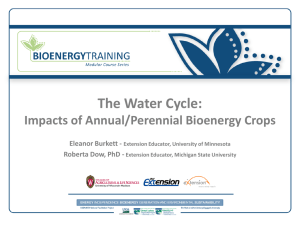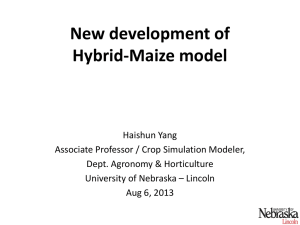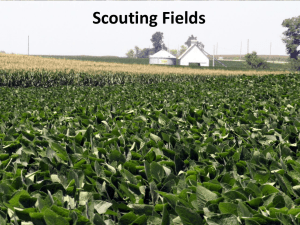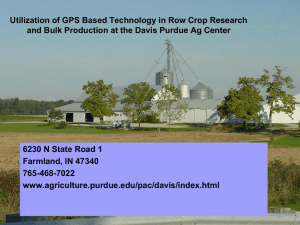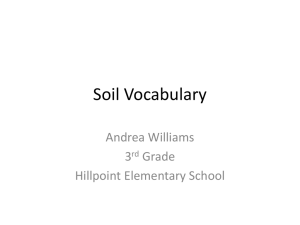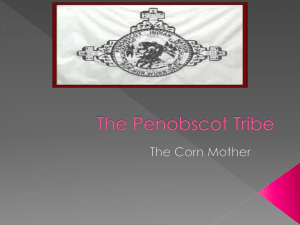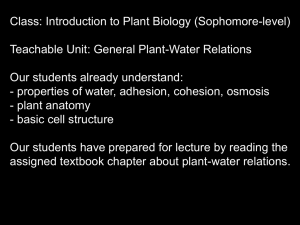Soil N, Urbana, 2012 - Illinois Council on Best Management Practices
advertisement
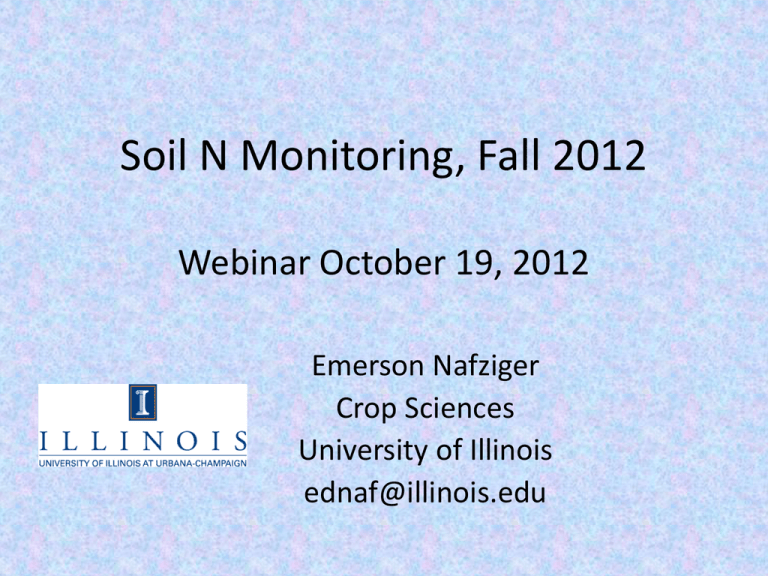
Soil N Monitoring, Fall 2012 Webinar October 19, 2012 Emerson Nafziger Crop Sciences University of Illinois ednaf@illinois.edu Percent of Total Uptake Nitrogen Uptake In Corn 100 90 80 70 60 50 40 30 20 10 0 Leaves Stalk, Tassel Remobilization Cob, Husks, Shank Grain 40 Days Stage:VE 0 V6 20 V12 40 V18 R1 R2 R3 R4 R5 60 80 Days After Emergence Source: Adapted from How a Corn Plant Develops, Special Report 48 Iowa State University 100 R6 120 On-farm N rate trials, N. IL following a dry 2005 and winter of 05-06 Corn following Soy, 2006 250 250 200 200 Yield, bu/ac Yield, bu/ac Corn following Corn, 2006 150 100 150 100 50 50 0 0 0 50 100 150 200 Total N rate, lb/ac 250 0 50 100 150 200 Total N rate, lb/ac 250 N Left After Harvest? • Warm March – mineralization started early and kept going (until soil dried out) • Normal N rates but short crop and less uptake • Early death/early end of N uptake • Rain after N uptake stopped mineralization • Unused fertilizer N + unused mineralized N = ?? • NO3-N in tile water a concern • Chance to carry over to 2013? How much N remains? Will it be there in Spring? Should N rates be reduced? Soil N, Urbana, 2012 400 Total N, lb/acre 350 300 250 200 Site 1 Site 2 Site 3 150 100 50 0 31-Aug 11-Sep 31-Aug 11-Sep 0 to 12" 12 to 24" Sampling time and depth Illinois Soil Nitrogen Monitoring Fall 2012 • Identify 20 x 20 ft site after harvest: – Following corn in 2012 (can take a few following soybean) – Can choose different soils, yield levels – Fields where corn will be grown in 2013 will allow adjustments based on spring samples • Collect samples after harvest and before NH3 application – last half of October, early November • Need GPS coordinates (center of area) – Accuracy at least .00001 degree; i.e., 40.23456° – If degrees, minutes, and seconds, need to xx.xx”, for example, 40° 14’ 4.42” Illinois Soil Nitrogen Monitoring Fall 2012 2 • If N was broadcast-applied in 2012, composite 4 to 6 probes from random places in the area and mix in a bucket • If N was banded (anhydrous or UAN) and soil hasn’t been tilled: – Take 2 cores in the band (separated by 5 ft or so down the row or in separate rows), 2 cores ~8 inches away from the band, and 2 cores ~15 inches away from the band – Composite the 6 cores as one sample, and mix in a bucket • Take two samples: one 0 to 1 ft. deep and a second one (from the same hole) 1 to 2 ft. deep. If the ground is too hard after harvest to collect samples to 2 ft, take only a 0 to 1 ft. sample. • If tillage occurs prior to sampling and the surface soil is fluffy, step on the soil surface to firm it up, then sample in the footprint. Illinois Soil Nitrogen Monitoring Fall 2012 3 • Take a generous cup of soil from the composited sample in the bucket and place it in the sample bag provided. Label bag with the site code (can use initials and date, for example) and sampling depth • Those not in the Growmark program request sampling materials from me at ednaf@illinois.edu • Need only: – Your shipping address – Number of sites you will sample or coordinate sampling for – Counties where sampling will be done Illinois Soil Nitrogen Monitoring Fall 2012 4 • I will forward the request to A&L Lab (copy to you) to send you the requested number of sample bags (2 per site) and forms and shipping boxes (with return service RS) • Samples should be sent to A&L within 24 hours of taking them (longer is OK if cool), or refrigerated if that is not possible – If you start to sample before supplies arrive, soil sample bags and refrigerate samples • You may get from A&L instructions to put several boxes (sites) together for shipping • Ship to A&L Monday through Thursday – not on Friday Funding for this project is being provided by the Council for Best Management Practices, thus there will be no cost to producers and those who take samples. The thought is to make this an ongoing project, with possible funding from the revised fertilizer checkoff (NREC). What Will the Numbers Tell Us? • In the top foot of soil (4 million lb per acre), 1 ppm of NO3-N or NH4-N = 4 lb N/acre • Fall soil N values can’t tell us how much we will be able to adjust N rate for the 2013 corn crop, but they will: – Tell us the potential for loss if tile lines start running in spring 2013 – Justify decreasing fall NH3 rates given the expectation that some of this N may carry over: We can’t adjust fall rates downward next spring if there’s still N left… What Happens to the Data? • Soil N numbers (ppm NO3- and NH4+) will be sent to the sample coordinators for distribution to those whose fields were sampled • Values will be put on an Illinois map (no names, hidden GPS values) to show how much N there is Fall 2012 NH3 • Need to wait until soils have cooled to <50° • Use of nitrification inhibitor is suggested • If soils are dry, need to take care (or delay) to get proper sealing – NH3 needs to dissolve in soil water and stay dissolved – A lot of NH3 dissolves in a little water, but releasing NH3 gas into a dry soil means some will escape – If soils continue to dry after application more will go out of solution: can lose more over time – Tillage before or after application can expose more soil to drying • Consider rate adjustments, especially if more N is slated for spring (last rate adjustment) and there is (or you suspect there is) soil N now Soil N, Spring 2013 • The hope is that sites sampled in fall 2012 will be sampled again in spring 2013, close to the time of planting, but at least before last N application – Will use same procedures as for fall 2012 – Have the ability to sample in fall-applied sites to see form and amount remaining • It’s normal for much fall NO3 to disappear by the next spring, if tile lines run and/or it is wet when soils are warm • But the amount of soil N in fall 2012 appears to be greater than normal, and most tiles are not yet running, so there might be some N left for the 2013 (corn after corn) crop What About N for the 2013 Crop? • We like the MRTN • For corn following soybean, N needs should be normal – that is, subject to weather (N loss and crop growth) – There is no evidence that low soybean yields in 2012 would mean higher N needs for the corn crop that follows in 2013 • For corn following corn: – Possibility of carryover N – will know in the spring • MRTN minus lb soil N – adjustment? – Less residue means less N tieup, so might mean slightly less N needed – As usual, much depends on spring conditions: moisture, loss potential, soil warmup, crop growth, etc. Nutrients in Corn Stalks • Measurements of removal in 2010, leaving the lower foot of stalk, per ton of dry residue: – 15 lb N ($6.00 at $0.40/lb) – 6 lb P2O5 ($3.00 at $0.50/lb) – 20 lb K2O ($8.40 at $0.42/lb) – Total value: $17.40 per ton of dry residue • These are not “fixed”: N and (especially) K leach out with weathering, and amounts will decrease over time in the field


